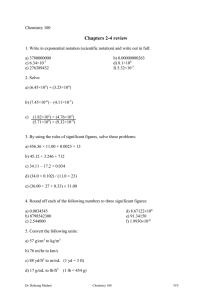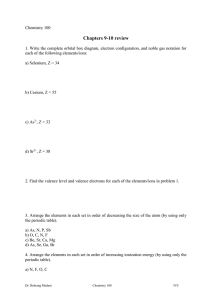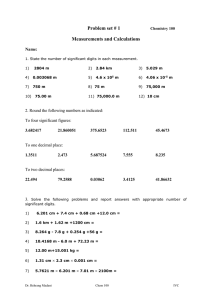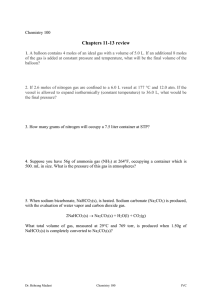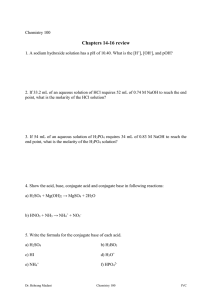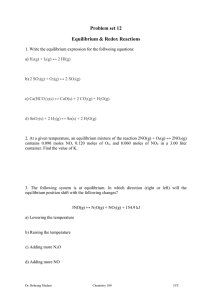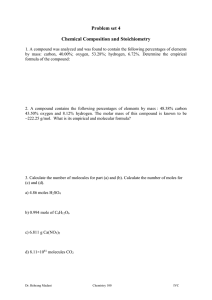Attention: Please study problem set 1, 2, and 11 as well. This... does not contain these chapters.
advertisement
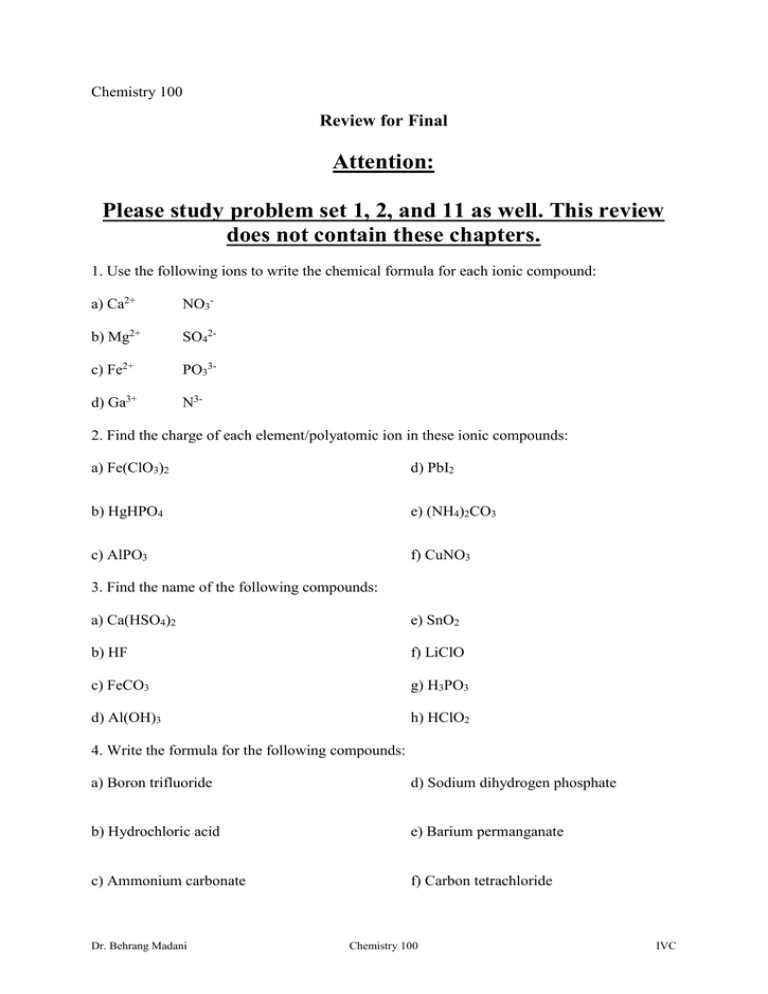
Chemistry 100 Review for Final Attention: Please study problem set 1, 2, and 11 as well. This review does not contain these chapters. 1. Use the following ions to write the chemical formula for each ionic compound: a) Ca2+ NO3- b) Mg2+ SO42- c) Fe2+ PO33- d) Ga3+ N3- 2. Find the charge of each element/polyatomic ion in these ionic compounds: a) Fe(ClO3)2 d) PbI2 b) HgHPO4 e) (NH4)2CO3 c) AlPO3 f) CuNO3 3. Find the name of the following compounds: a) Ca(HSO4)2 e) SnO2 b) HF f) LiClO c) FeCO3 g) H3PO3 d) Al(OH)3 h) HClO2 4. Write the formula for the following compounds: a) Boron trifluoride d) Sodium dihydrogen phosphate b) Hydrochloric acid e) Barium permanganate c) Ammonium carbonate f) Carbon tetrachloride Dr. Behrang Madani Chemistry 100 IVC 5. Predict whether a precipitate will form when aqueous solutions of the following compounds are mixed. If a precipitate will form, write its formula, and write a net ionic equation. Identify the spectator ions. a) K2SO4(aq) + Ba(NO3)2(aq) b) NaOH(aq) + H2SO4(aq) c) AgNO3(aq) + CuCl2(aq) d) AlCl3(aq) + Li2CO3(aq) 6. Balance the following equations: a) Na+(aq) + CO32-(aq) + Sr2+(aq) + Cl-(aq) SrCO3(s) + Na+(aq) + Cl-(aq) b) Cu + Zn2+ Cu+ + Zn c) Al3+ + Fe Al + Fe3+ d) Fe2+ + Cu2+ Fe3+ + Cu 7. In the following equations, which species are oxidized and which species are reduced? Which ones are the oxidizing agents and which ones are the reducing agents? a) 2Fe3+ + 3Ni 2Fe + 3Ni2+ b) C2H4O(l)+ H2O2(l) C2H4O2(l) + H2O(l) 8. Identify each of the following unbalanced reaction equations as belonging to one or more the following categories: precipitation, acid-base, oxidation-reduction, synthesis, decomposition, single replacement, double replacement, or combustion. a) I4O9(s) I2O6(s) + I2(s) + O2(g) Dr. Behrang Madani Chemistry 100 IVC b) HCl(aq) + AgC2H3O2(aq) AgCl(s) + HC2H3O2(aq) c) SiCl4(l) + Mg(s) MgCl2(s) + Si(s) d) Ca(OH)2(aq) + H2SO4(aq) CaSO4(s) + H2O(l) 9. Considering the following reaction: NaClO2(aq) + Cl2(g) → ClO2(g) + NaCl(aq) If 78.3g of NaClO2 is used, how many grams of NaCl will be formed? 10. Lead(II) nitrate and aluminum chloride react according to the following equation: 3Pb(NO3)2 + 2AlCl3 → 3PbCl2 + 2Al(NO3)3 In an experiment, 8.00 g of lead nitrate reacted with 2.67g of alumium chloride to give 5.15 g of lead chloride. a) Which reactant was the limiting reagent? b) What was the percent yield? 11. Using the equation: Fe2O3(s) + 3CO(g) → 2Fe(s) + 3CO2(g) If 105g of Fe2O3 reacts with 21g CO, what volume of CO2 gas will be formed at STP condition? 12. Write the complete orbital box diagram, electron configuration, and noble gas notation for each of the following elements/ions: a) Iodine, Z = 53 Dr. Behrang Madani Chemistry 100 IVC b) Krypton, Z = 36 c) Se2-, Z = 34 d) Ba2+, Z = 56 13. Find the valence level and valence electrons for each of the elements/ions in problem 12. 14. Arrange the elements in each set in order of decreasing the size of the atom (by using only the periodic table). a) Ge, C, Si, Sn b) Be, B, Li c) K, Rb, Na, Li d) Sr, I, Sb, Te 15. Arrange the elements in each set in order of increasing ionization energy (by using only the periodic table). a) As, Br, Se, Ga b) P, As, N, Sb c) Ba, Cs, Pb d) Sr, Be, Ca, Mg 16. Find the location and the name of the following elements by using their electron configurations. a) 1s22s22p63s23p64s2 Dr. Behrang Madani Chemistry 100 IVC b) 1s22s22p63s23p64s23d104p65s1 c) 1s22s22p63s23p64s23d104p65s24d105p2 d) [Ar]4s23d104p4 17. What is the same and what is the difference in the electron configuration of: a) Ca and Sr b) P and As 18. Arrange the elements in each set in order of increasing electronegativity (by using the periodic table). a) As, N, P, Sb b) O, C, N, F c) Be, Sr, Ca, Mg d) As, Se, Ga, Br 19. Draw the Lewis structure for each covalent compound. a) CH3OCH3 b) CH3CH2OH c) HCN d) COCl2 20. Predict the shape of each molecule and bond angles by using VSEPR. a) SCl2 b) CH3COOH Dr. Behrang Madani Chemistry 100 IVC c) C2H2 d) P2H4 21. In problem 20, which of the molecules are polar? Why? 22. In K2O, use the electron configuration of potassium and oxygen and then K+ and O2- to show how an ionic bond is produced between them. The electron configuration of potassium ion and oxide ion are similar to which noble gases? 23. Describe how we would prepare the following solutions: a) 280 mL of 27% v/v solution of ethanol, C2H6O, in water. b) 623 mg gram of 13.7% w/w solution of coffee in water. 24. Find w/v % of a solution if 0.23 moles NaI is dissolved in water to make 2.3L solution? 25. Suppose 82.6g sucrose, C12H22O11, dissolved in enough water to give 725 mL solution. What is the molarity of this solution? Dr. Behrang Madani Chemistry 100 IVC 26. Assuming that the volumes are additive. 263 mg of ammonium sulphate, (NH4)2SO4, is dissolved in water to make 3.6L solution. If we add 1.2 L water to this solution, what would be the molarity? 27. What mass of potassium chloride would be needed to precipitate the silver ion from 98 mL of 0.26 M AgNO3 solution? KCl(aq) + AgNO3(aq) → AgCl(s) + KNO3(aq) 28. In question 27, how many molecules (formula) of silver chloride form when a 1.66 g of KCl is added to 73 mL of 0.64 M AgNO3 solution? 29. Find the oxidation state (oxidation number) for each element in the following molecules/ions. a) S in H2SO4? b) C in Na2CO3? c) Cr and C in Cr(C2H3O2)2? d) P in HPO42- ? Dr. Behrang Madani Chemistry 100 IVC e) Cr in HCr2O7- ? 30. Given the unbalanced equation below: Fe2+(aq) + Cr2O72-(aq) + H+(aq) → Fe3+(aq) + Cr3+(aq) + H2O(l) a. identify the oxidation state of each element b. identify the oxidizing agent c. identify the reducing agent 31. Given the unbalanced equation below: B2O3(s) + Cl2(g) → BCl3(l) + O2(g) a. identify the oxidation state of each element b. identify the oxidizing agent c. identify the reducing agent 32. Blance each chemical equation using half-reactions method. a) BrO3-(aq) + Cu+(aq) → Br-(aq) + Cu2+(aq) b) S2O82-(aq) + Cr3+(aq) → SO42-(aq) + Cr2O72-(aq) c) MnO4-(aq) + C2O42-(aq) → Mn2+(aq) + CO2(g) Dr. Behrang Madani Chemistry 100 IVC 33. A balloon contains 4 moles of an ideal gas with a volume of 5.0 L. If an additional 8 moles of the gas is added at constant pressure and temperature, what will be the final volume of the balloon? 34. If 2.6 moles of nitrogen gas are confined to a 6.0 L vessel at 177 °C and 12.0 atm. If the vessel is allowed to expand isothermically (constant temperature) to 36.0 L, what would be the final pressure? 35. How many grams of nitrogen will occupy a 7.5 liter container at STP? 36. Suppose you have 56g of ammonia gas (NH3) at 264°F, occupying a container which is 500. mL in size. What is the pressure of this gas in atmospheres? 37. When sodium bicarbonate, NaHCO3(s), is heated. Sodium carbonate (Na2CO3) is produced, with the evaluation of water vapor and carbon dioxide gas. 2NaHCO3(s) Na2CO3(s) + H2O(l) + CO2(g) What total volume of gas, measured at 29C and 769 torr, is produced when 1.50g of NaHCO3(s) is completely converted to Na2CO3(s)? 38. Suppose that 4.18g of oxygen gas and 3.68g of nitrogen gas are confined in a 11.3-L container at 36°C. What would be the pressure of container? Calculate the partial pressure of each gas in this mixture. Dr. Behrang Madani Chemistry 100 IVC
